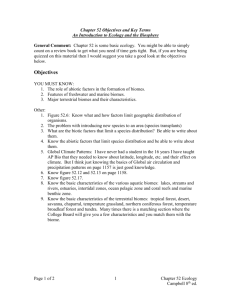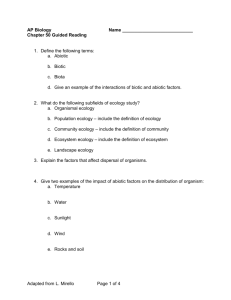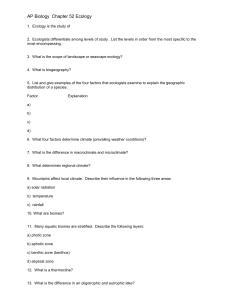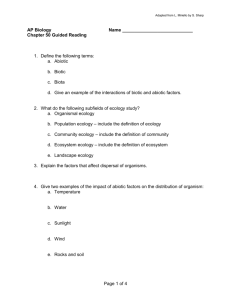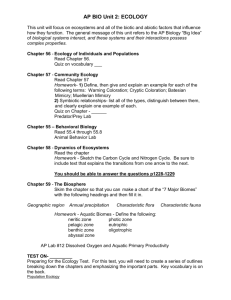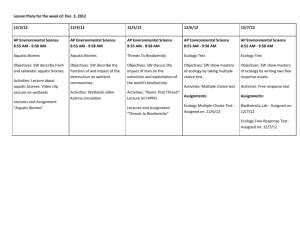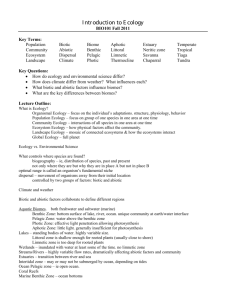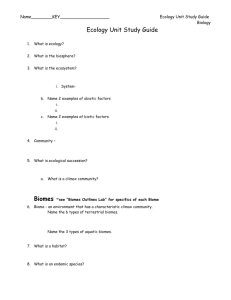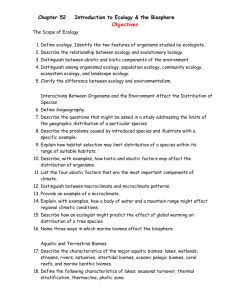Ch. 50 notes
advertisement
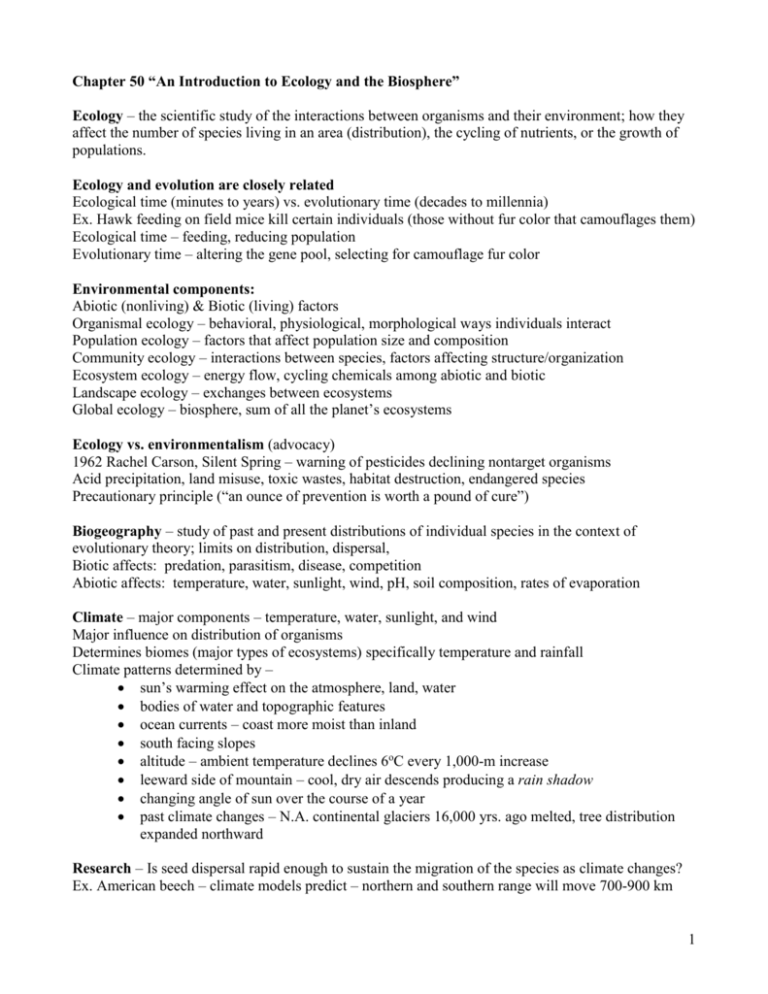
Chapter 50 “An Introduction to Ecology and the Biosphere” Ecology – the scientific study of the interactions between organisms and their environment; how they affect the number of species living in an area (distribution), the cycling of nutrients, or the growth of populations. Ecology and evolution are closely related Ecological time (minutes to years) vs. evolutionary time (decades to millennia) Ex. Hawk feeding on field mice kill certain individuals (those without fur color that camouflages them) Ecological time – feeding, reducing population Evolutionary time – altering the gene pool, selecting for camouflage fur color Environmental components: Abiotic (nonliving) & Biotic (living) factors Organismal ecology – behavioral, physiological, morphological ways individuals interact Population ecology – factors that affect population size and composition Community ecology – interactions between species, factors affecting structure/organization Ecosystem ecology – energy flow, cycling chemicals among abiotic and biotic Landscape ecology – exchanges between ecosystems Global ecology – biosphere, sum of all the planet’s ecosystems Ecology vs. environmentalism (advocacy) 1962 Rachel Carson, Silent Spring – warning of pesticides declining nontarget organisms Acid precipitation, land misuse, toxic wastes, habitat destruction, endangered species Precautionary principle (“an ounce of prevention is worth a pound of cure”) Biogeography – study of past and present distributions of individual species in the context of evolutionary theory; limits on distribution, dispersal, Biotic affects: predation, parasitism, disease, competition Abiotic affects: temperature, water, sunlight, wind, pH, soil composition, rates of evaporation Climate – major components – temperature, water, sunlight, and wind Major influence on distribution of organisms Determines biomes (major types of ecosystems) specifically temperature and rainfall Climate patterns determined by – sun’s warming effect on the atmosphere, land, water bodies of water and topographic features ocean currents – coast more moist than inland south facing slopes altitude – ambient temperature declines 6oC every 1,000-m increase leeward side of mountain – cool, dry air descends producing a rain shadow changing angle of sun over the course of a year past climate changes – N.A. continental glaciers 16,000 yrs. ago melted, tree distribution expanded northward Research – Is seed dispersal rapid enough to sustain the migration of the species as climate changes? Ex. American beech – climate models predict – northern and southern range will move 700-900 km 1 over the next century; will have to migrate 7-9 km/yr to maintain distribution; since the Ice Age its rate of migration only 0.2 km/yr; extinction is imminent without human assistance. Aquatic Biomes: Freshwater vs marine – physical and chemical differences Marine – 3% average salt concentration; freshwater - < 1% Marine ecological importance: provides most of the planet’s rainfall, 75% earth’s surface, contribute to climate and wind patterns, large amount of world’s O2 supply from algae and photosynthetic bacteria, atmospheric carbon dioxide consumption by respiration Stratified: photic zone – light for photosynthesis, aphotic zone, benthic (bottom) – benthos organisms feeding on detritus; thermocline – narrow stratum of rapid temp change Aquatic Community distribution determined by: Depth of the water Distance from shore Open water versus bottom Major aquatic biomes: Lakes, wetlands, streams, rivers, estuaries, intertidal biomes, oceanic pelagic biomes, coral reefs, marine benthic biomes Freshwater lakes: oligotrophic (deep, nutrient poor, oxygen rich, little life); eutrophic (shallow, nutrient rich, oxygen poor); littoral zone – shallow, close to shore; limnetic zone – open surface water. Wetlands: supports aquatic plants, marshes, bogs, and swamps, most productive biomes on Earth, high organic production and decomposition, high capacity to filter dissolved nutrients/chemical pollutants Streams/rivers: moving continuously in one direction, headwaters – cold, clear, turbulent, swift; carry little sediment, few minerals; accumulates O2 and nutrients along the way Estuaries: transition between river and sea, salinity varies greatly, abundance of fish, invertebr4ate species, and crucial feeding areas for waterfowl. Intertidal zone: periodically submerged and exposed by tides; organismal distribution by stratum due to oxygen and moisture requirements Oceanic pelagic biome: open blue water, high oxygen levels, low nutrient levels, 70% Earth’s surface Coral reefs: photic zone, tropic marine, high water clarity, formed by calcium carbonate skeletons of coral animals, mutualistic dinoflagellate algae live within the tissues of the corals, home to assortment of vertebrates and invertebrates. Marine benthic zone: neritic zone – coastal; pelagic zone – offshore; abyssal zone – deep, 3oC, extremely high pressure; deep-sea hydrothermal vents – chemoautotrophic prokaryotes oxidize H2S from a reaction of volcanically heated water with dissolved sulfate (SO42-) 2

